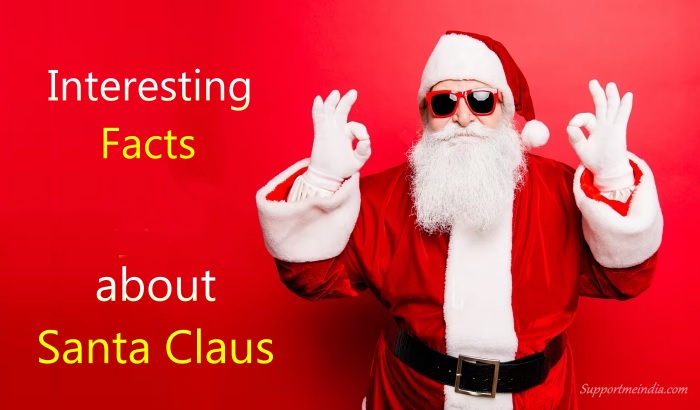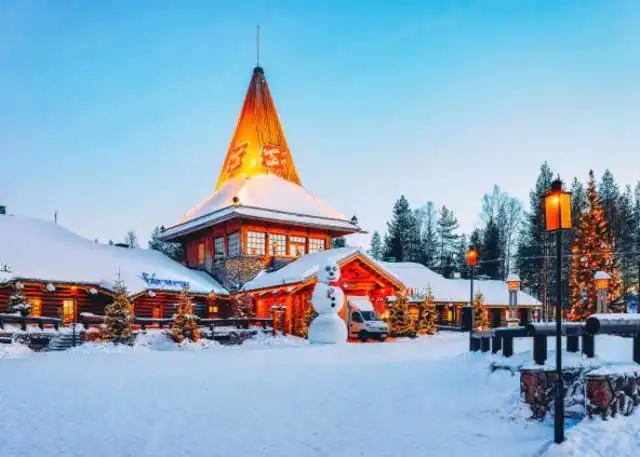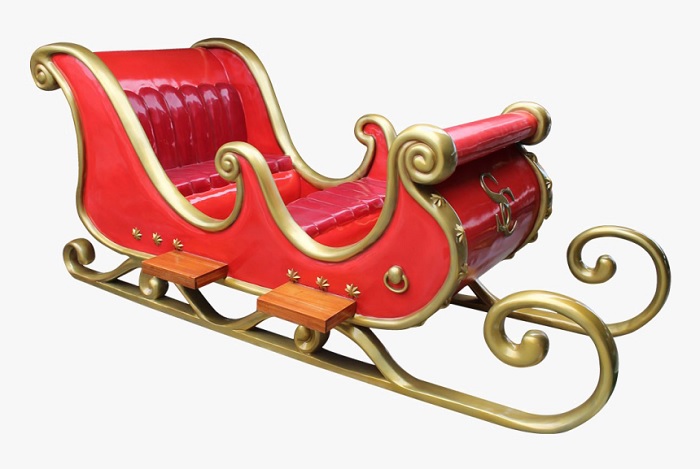There is no figure more iconic than Santa Claus for children during the Christmas season. Parents teach their kids the importance of being polite and well behaved throughout the year in hopes of making their “good” list. Children sing songs about him and place a plate of holiday cookies for his arrival. But where exactly did Santa get his start, and how did he persist as an iconic Christmas person over the years? Check out these facts you might not have known about Jolly Ol’ Saint Nick.

Santa Claus is one of the most ubiquitous figures in modern culture. A version of him is celebrated all over the world, and while there are some notable differences—in the Netherlands, for example, Santa has a sidekick named Grumpus who threatens to kidnap naughty children—it’s usually the same. Boils down to a general premise: If children have been treated well throughout the year, a magical bearded man will break into their homes at night and leave presents.
You might think you know everything there is to know about Kris Kringle, or jolly Old Saint Nick, or any of the dozens of different names they’re called around the world. But we can bet that Santa Claus has some fun facts you’ve never heard. Santa Claus Things your never knew.
50+ Interesting Facts about Santa Claus You Never Knew
Maybe you’re one of those Scrooge who doesn’t care about Santa Claus anymore because you think he’s just a myth. Well, but you would definitely like to know these interesting facts about them.
1. He is based on a real person
We know Santa best as the character who presents him every Christmas Eve, but it turns out that his origins are far from fiction. The story of Santa dates back to 280 AD in what would be today Turkey. Saint Nicholas was a monk who traveled to the countryside to help the poor and sick. One story claims that he also used his property to provide dowry for three poor sisters, to save them from being sold by their father. He became known as the protector of children and sailors, and by the Renaissance he was one of Europe’s most popular saints.
2. Its name comes from the Netherlands
When the people of the Netherlands moved to the colonies of the New World, they brought with them the legend of Sinterklaas, which is Dutch for St. Nicholas. By the late 1700s, the story of the eclectic Sinterklaas reached American pop culture as Dutch families gathered to honor the saint’s death, and over time, the name evolved into Santa Claus.
3. Christmas was once against the law
The Puritans of New England were not fans of Santa Claus. Following the tradition of their British ancestors, who declared that December 25 should be a day of “fasting and humiliation”, the General Court of the Massachusetts Bay Colony passed a law in 1659 which warned that “whoever shall be found to observe any such day. What was the big deal? Stefan Nissenbaum, author of The Battle for Christmas, explained in an interview that “the Puritans believed Christmas was originally just a pagan custom that Catholics took over without any biblical basis for it.”
4. Christmas wasn’t always about Santa bringing gifts
In early America, Christmas was not the festive holiday we know and love today. It was abandoned in New England, lacking a cheerful person who would bring gifts and celebrated outside with wine. A series of poems and stories in the early 19th century redefined the holiday by giving St. Nick a makeover and focusing on themes of family and togetherness.
5. He didn’t always have a round stomach
In 1809, author Washington Irving helped shape the image of Santa Claus in his book “Knickerbocker’s History of New York.” In the novel, he describes Saint Nicholas as a pipe-smoke, the slender man flying over rooftops in a wagon giving gifts to good children and switching the bad.
6. He eats too much sugar!
Santa didn’t get the slightest round stomach that trembles when he laughs like a bowl full of jelly from eating too much broccoli. No, Kris Kringle loves her sweets. And she has millions of children around the world who promote her bad habits. If each house he visits leaves an average of two cookies for Santa, that is, in one evening, he consumes 374 billion calories, 33,000 tons of sugar and 151,000 tons of fat. To burn off all those empty calories, Santa would need to run for about 109,000 years. Good luck with that, Santa!
7. A poem popularized his image
In 1822, Clement Clarke Moore wrote a poem for his children called “A Visit from St. Nicholas”. In the poem, Moore describes St. Nicholas as a “jolly old elf” who has supernatural abilities such as being able to enter a chimney with a chime of his head. The poem was published anonymously and is popular today as “The Night Before Christmas”.
Irving’s book describes Santa as a small wagon with only a reindeer guiding him along the way. Moore’s “A Visit from St. Nicholas” changed that narrative. In his poem, Santa Claus is guided “on a miniature sleigh” by eight flying reindeer.
8. Poetry also introduced his deer
Irving’s book describes Santa as a small wagon with only a reindeer guiding him along the way. Moore’s “A Visit from St. Nicholas” changed that narrative. In his poem, Santa Claus is guided “on a miniature sleigh” by eight flying reindeer.
9. Santa’s favorite reindeer is 80 years old
The most famous reindeer of all, Rudolph, came more than a century after his eight counterparts. In 1939, Robert L., a copywriter at the Montgomery Ward department store. May wrote a story to drive traffic to the store during the holidays. May used a rhyming pattern similar to “The Night Before Christmas” to tell the story of Rudolph, a young reindeer who is teased by her bright, red nose, but on a foggy night, she guides Santa. because he gives his gift. The story sold over 2 million copies, and in 1949, it was made into a popular song sung around Christmas to this day.
10. He did not always wear a red suit
Moore’s poem created an American icon, but it did not standardize the depiction of Santa. In the 19th century, some images depicted a man in a different colored suit, others seen him in miniature and sometimes riding a broomstick instead of a sleigh.
11. His iconic look was drawn by a political cartoonist
In 1881, Thomas Nast – the acclaimed political cartoonist famous for creating the elephant representing the Republican Party and the donkey of the Democratic Party – brought to life the image of Santa we know today. Nast drew Santa as a round, cheerful man with a full, white beard, undersized longzones with white trimmings, and a sack full of toys.
12. Sending him the letter began with a drawing
Nast will go on to describe many of the things we associate with Santa today. In an example shown in Harper’s Weekly in 1871, the cheerful fellow is shown sitting at his desk, smoking a pipe and sorting letters from “parents of nice kids” and “parents of naughty kids”. This image helped popularize the idea of sending letters to Santa. And in an 1886 illustration titled “Santaclausville, NP,” Nast gives children and parents a place to send their mail: the North Pole.
13. His home was chosen for a reason
If you’re wondering why the North Pole of all places was chosen as Santa’s home, the answer is simple: keep your reindeer alive. Before Nast began drawing Santa, Irving had already described Santa Claus as having eight reindeer to guide him along the way. Reindeer tend to live in cooler climates – today they have evolved to survive in temperatures as low as minus 88 degrees Fahrenheit. It only made sense that Santa would stay where the chilly weather would be best suited for his helpers. Although it would be half a century after Nast’s visions that the explorers would reach the North Pole, the location was chosen for its perceived coolness.
14. He was once a bachelor. He remained a bachelor for many years
For decades, Santa was a cheerful but unmarried man who gave presents to children. It was not until 1849 that it was first mentioned that Santa had a spouse in James Rees’ “A Christmas Legend”. And in 1851, Santa’s spouse was officially called “Mrs. Claus” by a student writer for the Yale Literary Review. Now, Mrs. Claus is just as popular as her counterpart and is often portrayed as being responsible for ensuring Christmas goes smoothly.

Santa (or a variant of Santa) has been around for centuries, and has been a part of American culture since at least the late 1700s. But it was not until the mid-19th century that one wondered whether Santa would ever abandon his bachelor ways and settle down. His spouse was first revealed in an 1849 short story—”A Christmas Legend,” written by a Philadelphia missionary named James Rees—and Mrs. Claus soon became a regular appearance in Christmas tales. But it wasn’t until 1889, in a poem entitled “Goody Santa Claus on a Sleigh Ride,” that she began to demand more of the holiday spotlight. “Why should you have all the glory of the Christmas joy story?” She asks her husband.
15. He’s not the only gift giver around the world
Santa has been popularized in American culture as a gift-bringer, but around the world, many characters have been attributed to bringing joy and gifts to well-to-do children. Swiss and German kids have Christkind. Scandinavian children have an elf named Jultomten who is said to deliver gifts in a sleigh pulled by goats. And in France, children are told that Père Noël stuffs their shoes with presents.
16. He has many nicknames
We know him as Santa, but he is known by many other names. In addition to the big sc, he is also known as Jolly Old St. Nick, St. Nick, Father Christmas, Old Man Christmas and Kris Kringle.
We know him as Santa, but he goes by many names. Other than the big S.C., he is also known as Jolly Old St. Nick, Saint Nick, Father Christmas, Old Man Christmas and Kris Kringle.
17. Department Store Santa has been around for more than a century
In 1841, a shop in Philadelphia attracted thousands of children by offering them the opportunity to see a life-size Santa model. Other stores heard the news and headed to the shop. Soon the children were told they could see a “live” Santa Claus. Fun Fact: Since 1924, Macy’s Santa has appeared at nearly every Macy’s Thanksgiving Day parade, where thousands of children and adults alike line up to see the merry man ring every year during the holiday season.
18. Coca-Cola helped popularize the modern Santa form
The popular soda brand Coca-Cola also helped shape the image of Santa. In 1931, the company collaborated with illustrator Hayden Sundblom to depict a “warm, friendly and pleasantly plump” figure in a red coat with a white beard. From 1931 to 1964, Sundblom’s illustrations were used in commercials in which Santa would deliver presents and pause for a moment to enjoy a Coke. Sundblom’s Santa became a global icon, and his artwork depicting Santa has been featured in art museums around the world. The history of Santa is one of many things you didn’t know about Coca-Cola.
19. Ever since he started shilling for Coca-Cola, he has only worn red
Santa has had a wide range of colorful outfits over the years—green, brown, blue and even tan—but it is only from 1931 that he has been known to wear a predominantly red and white suit. go. This is thanks to the Coca-Cola Company, which used Santa Claus in the early ’30s to sell Coke products, and of course produced it in the brand’s trademark colors. It has remained so ever since, and remains one of the centerpieces of Santa Coke’s holiday advertising campaign.
20. Stockings were once filled with presents for Santa
Santa has been known to leave presents for good boys and girls in stockings and under trees. But before giving milk and cookies became a tradition, families hung stockings by the fireplace and gave them presents when Santa arrived.
21. His favorite tradition started during the Great Depression
Leaving breakfast for Santa is a common Christmas tradition. But the rise of its popularity occurred during the Great Depression in the 1930s. In an effort to teach children the importance of showing gratitude during economic hardships, parents encourage their children to leave milk and cookies for Santa and a carrot or two for their reindeer.
22. Different parts of the world leave different feasts for Santa
After departing from the American skies, Santa is treated around the world with various gifts and treats. In Australia and the United Kingdom, children skip the sherry and mince the pie. Swedish children skip rice porridge. And Santa can expect an even bigger surprise upon his arrival in Ireland: a pint of Guinness.
23. Santa is on the naughty list of some countries
In places such as Austria and the Czech Republic where communities seek to preserve the history of their original gift-bringers and practices, Santa is not recognized or celebrated.
24. Sometimes he sends letters to the children
Although Santa receives millions of letters each year, he can also send them. In the 1850s, the poet Henry Wadsworth, Fanny Longfellow’s wife, wrote letters to her children commenting on Santa’s behavior throughout the year. Today, the United States Postal Service has partnered with Santa and parents to send letters from the cheerful person postmarked to the North Pole.
25. He also has his own city

While Santa’s home is generally identified as the North Pole, there is another location hoping to steal the throne. Santa Claus, a city in Indiana, describes itself as “America’s Christmas Hometown”. The magical Christmas town is recognized for its theme and famous places like the 1880 Santa Claus Church, the Santa Claus Post Office and a 22 foot tall Santa Claus statue.
26. You can call Santa
Contacting Santa Claus ahead of the big day has never been easier. While some rely on the postal service to fulfill their wishes, Santa can now be contacted by calling the Santa Hotline.
27. You can email Santa
Thousands of children around the world still send letters to Santa, but tech-savvy youth can send an email to Santa instead. Emailsanta.com is just one site that provides users with a direct pipeline to gift- givers before the start of the holidays.
28. You can track Santa’s progress around the world
Santa has to move fast to deliver presents to kids all over the world. But if you want to continue her journey, it has never been easier. Google’s Santa Tracker allows you to walk with Santa Claus as he makes his way to each country on Christmas Eve. And NORAD has its own Santa Tracker that can be downloaded as an app on any device a few days before the big night.
29. France sends the most letters to Santa
A 2013 study by the Universal Postal Union found that France was responsible for sending the most letters to Santa—1.7 million to be exact. The second was Canada with 1.3 million characters, and the third was the US with over 1 million characters. Santa receives billions of letters each year from children around the world, but if you thought most of them were coming from the United States, you’d be wrong. According to statistical data, the country that sends the most paper mail to Santa Claus every holiday season is none other than France. That’s right, France’s boys and girls are sending a staggering 1.7 million letters to jolly Old St. Nick, compared to 1.35 million from Canada and just over a million letters from the United States. Mexico and Latin America didn’t even make the list,
30. Children used to light letters for Santa
Before the United States Postal Office was established in 1775, children burned their letters to Santa in the hope that the ashes would reach him.
31. He gives gifts to 22 million children in an hour
Countless movies and stories have told us that Santa is capable of delivering presents to children around the world in one night. But to determine how he could distribute gifts around the world without losing a home, The Atlantic crunched the numbers using data from the CIA, and after weighing several factors, it estimated That in order to fulfill his holiday duties, Santa must deliver presents to 22 million children per hour. That is, 365,000 children in a minute and 6,100 children in a second.
32. He has his own university
Becoming a Gala Santa is a daunting task, and for anyone with the task, it will take some serious work to earn the title. That’s where Santa University comes in. Located in Westminster, Colorado, the four-day training program welcomes approximately 1,000 naturally bearded people looking forward to learning the ins and outs of being the best possible Santa.
33. It has its own postal code
Leaders in Canada are positive that Santa Claus exists and that he is indeed Canadian. And to prove it, they have assigned him his own postal code. Anyone in the country who wishes to send a letter to Santa during the Christmas season can address it to Santa Claus, North Pole, H0H 0H0, Canada.
34. He made a guest appearance in a comic book
In the “Marvel 1991 Holiday Special” the X-Men meet Santa Claus, a mutant who identifies as Kris Kringle and can turn people into toys.
35. Marvel Comics named Santa “the most powerful mutant ever”
We knew that Santa had magical powers, but who knew he was also a true mutant? Not only that, but apparently he’s also “the most powerful mutant ever registered”, and that’s according to Cerebro, the mutant-detection tool created by Professor X for the Marvel Universe’s X-Men. We learned this shocking news in a special 1991 X-Men comic, in which a team of heroes travel to New York City to investigate so-called Omega Level mutants, and discover Santa’s abilities that include immortality, telepathy, Teleportation, weather manipulation, molecular are involved. Manipulation, immunity to cold and heat, and gravity manipulation.
36. He has a pilot’s license and a (Canadian) passport
Lest you worried that Santa wasn’t legal to fly, he was officially issued a pilot’s license from the US government in 1927. He also has a passport, but this is a bit more controversial. Santa Claus and Mrs. Claus both obtained their own e-passports from Canada in 2013. During a special ceremony in Toronto, Immigration Minister Chris Alexander said of the holiday pairing, “Like many Canadian citizens who enjoy extensive travel around the world, Klaus’ was thrilled to receive his e-passport. -The world’s most accepted and safest travel documents… whether you’re traveling by car, by boat, or with a team of flying reindeer.” The United States and every other country have yet to respond with the Santa Claus claim, but there is an international phenomenon written on it.
37. He gives coal to children who are abused for the cause
Santa and his elves work hard to prepare and deliver presents to the kids on the “good” list. But for those who don’t make the cut, Santa keeps a lump of coal in his stockings. He does this for one simple reason: It’s convenient. Santa Claus goes down the chimney to leave the presents. Along the way, they encounter coal, a common form of fuel for chimneys in the 19th century. Then he puts the coal in the stockings.
38. It’s been there for centuries
The legend of Santa Claus has been around for more than 200 years. And do you still believe that a cheerful, modest man who gives gifts or not, his legacy lives on. If Santa’s charm has long waned in your imagination, rekindle that childhood spark by visiting the world’s most magical Christmas towns and villages.
39. His sleigh is probably the fastest car ever
Santa doesn’t get as much credit as he does in just one night. It’s one thing to say that he visits every boy and girl and gives them gifts, but when you crunch the numbers, you start to realize how staggering this really is. There are approximately 2.1 billion children in the world, and an average of 2.5 children per family. That means it would have to make 842 million stops on Christmas Eve, and 31 hours to do it (thanks to the time zone difference). It has been calculated that to get to each house in that time period, his sleigh would have to travel at 1,800 miles per second. Compare this with NASA’s Juno spacecraft, often considered the fastest man-made object, reaching speeds of only 40 miles per second.

40. Santa’s chimney distribution system was invented by the same man who dreamed of the Headless Horseman
We are indebted to Washington Irving, the author more widely remembered for giving the world “The Legend of Sleepy Hollow,” a better way for Santa to give presents than sliding through a window. Is. It was in Irving’s satirical short story from 1812, called “New York’s History of the Knickerbocker”, where St. Nick is first described as a “rattle under the fireplace” to “give his annual gifts to children”. Bring it.” You thought the legend originated from “The Night Before Christmas”? No, that was about 12 years later, and though the more famous poem changed Irving’s version—Santa was given a sleigh with reindeer instead of a self-driving wagon—it’s Irving who’s been on the road for all those chimney trips. deserves credit for.
41. No one is really sure who wrote “Twas the Night Before Christmas”
When “A Visit from St. Nicholas” – or as it later became known, “Twas the Night Before Christmas” – was first published in a New York newspaper in 1823, no names were attached to it. It was sent anonymously to the Troy Sentinel and was published with a preface to the editors, which began: “We do not know to whom we are indebted to that tireless patron of children, the following description of Santa Claus … We thank you for that.”
In 1844, it was credited to a Bible college professor named Clement Clarke Moore, but there are some who insist that it was stolen from the true author, Henry Livingston, Jr., and even There was also an old manuscript to (allegedly) prove it. But of course, the supposed “evidence” was destroyed in the fire. The mystery continues to this day.
42. In the United States all letters addressed to Santa go to the same post office
From around 1914, all letters addressed to Santa Claus go to one place. No, not the North Pole; They end up at a small post office in Santa Claus, Indiana, where each letter containing a return address will receive a handwritten reply by the postmaster or one of his many “elf” volunteers. Pat Koch carries on the tradition he started with his father, and many of his assistants share his enthusiasm. “They’re writing us a letter, and they want an answer from Santa Claus,” Ed Rinehart, an elf at the Santa Claus Post Office, said in an interview. “So my job is to make sure those letters get back to them in the mail.” Outside the US, some countries have taken this a step further, creating unique zip or postal codes just for Santa. Be sure to include code 99999 when writing to Santa in Finland, And the correct postal code in Canada is oh-so-clever H0H 0H0. Thanks to Canada’s “Santa Letter-Writing Program” literacy initiative, Head Elf answers each letter individually.
43. Santa probably needs some more reindeer
For all the children in the world who give gifts to Santa on Christmas Eve, they need to carry at least 400,000 tons of toys in their sleigh. And to haul that kind of load a little more horsepower—er, buck power—than it’s rumored to travel. He reportedly only has nine reindeer—Dasher, Dancer, Prancer, Vixen, Comet, Cupid, Donner, Blitzen, and Rudolph—but it takes at least 360,000 magic to get him a sleigh with such a crude tonnage in the air. Deer will be needed.

44. There is a heated debate going on about how much Santa’s salary should be
Is Santa—the real Santa, thousands of mall Santas and impersonators—not worth the pay? The authors of Insure.com thought so, and they tried to calculate Santa Claus’s earning potential using wage data from the Bureau of Labor Statistics. His luckiest estimate is that Santa makes in the ballpark of $140,000 a year.
Well, not everyone agrees with this. A survey by Insure.com found that 29 percent of people thought Santa should make about $1.8 billion a year, while 29 percent thought they should work for free. A smaller group, 17 percent, believed that Mr. Klaus should make a little less than $100,000 a year, while 16 percent thought his salary should be between $100,000 and $200,000.
45. He is not particularly beloved by fans of the Philadelphia Eagles
More than 54,000 hometown fans watched the Philadelphia Eagles suffer a humiliating loss during a snowy December game in 1968, so suffice it to say the mood wasn’t festive. It was perhaps no surprise then that Santa Claus’s halftime appearance didn’t go according to plan. The joyful old elf was greeted, and then the crowd started throwing snowballs at her. So, did he at least feel postgame remorse? No. The general consensus among fans was “Santa was coming.” As for the person dressed like Santa for the game, when asked if he would repeat the performance, he replied, “Not at all. If it’s not snow, they’ll probably throw beer bottles.”
46. Two different cities claim to be the “true” home of Santa Claus
You’d think the town of North Pole, Alaska, had good reason to claim—as Santa Claus House general manager Paul Brown once said—that they are “the home of Santa Claus at the North Pole. If you want to.” To meet the real man, you come here.” But Rovaniemi, another city in Finland’s northernmost province, also insists they are “the only official hometown of Santa Claus,” according to a communications official for Rovaniemi Tourism. “And the Santa Claus office in Santa Claus Village is the only place in the world where you can meet Santa Claus 365 days a year.” Friends, relax! Can’t we find a compromise where Santa splits his time between the two hometowns?
47. They basically gave money so that the children would not grow up and become fit
Santa Claus wasn’t always a benevolent elf who leaves presents for children to reward good behavior. He began as St. Nicholas, a 4th-century bishop in Patara, or what is today called Turkey. Nicholas was terrified that the neighborhood girls might be sold into sex work by their father, so he would secretly distribute bags of gold to each family, which they could use as a dowry for their daughters and thus They are more likely to find a husband. As it was more than 900 years before the invention of the chimney, St. Nicholas would blow money through his windows.
He allegedly saved the children from being murdered by evil butchers and sold them as ham. If Santa had continued these traditions into modern times, Christmas would have been a very different holiday. “Merry Christmas! I hope Santa comes to visit you tonight and saves you from becoming a courtesan and/or lunch meat!”
48. There is no Santa Claus in Iceland
Before you grieve that Iceland never gets to St. Nick, they may actually be better than the rest of us. Instead of Santa Claus, they have thirteen “Yule Lads,” who are like mischievous mini-versions of Santa Claus, like bowl liqueurs, sausage swipers, pot scrapers, and spoon liqueurs. One of them visits Icelandic children every day between December 11 and January 6, leaving gifts in their shoes (assuming they have been treated well.)
There is also something called Grela, which is rumored to cook babies alive if they don’t listen to their parents, and a fearsome black cat called the Christmas Cat, which is rumored to be able to cook those babies. who have not worn at least one pair of new clothes. We feel harsh. Actually, we take it back. You must be sad for Iceland. It sounds like a terrible Christmas. And for more shake-in-the-boots stories, here are 23 Urban Legends That Are Totally True.
- Christmas Story – Merry Christmas Story in Hindi
- 50 Interesting Facts About Christmas – Christmas Facts in Hindi
To learn more amazing secrets about living your best life, you can follow us on Instagram, Facebook, Twitter, plus share this post with others!


